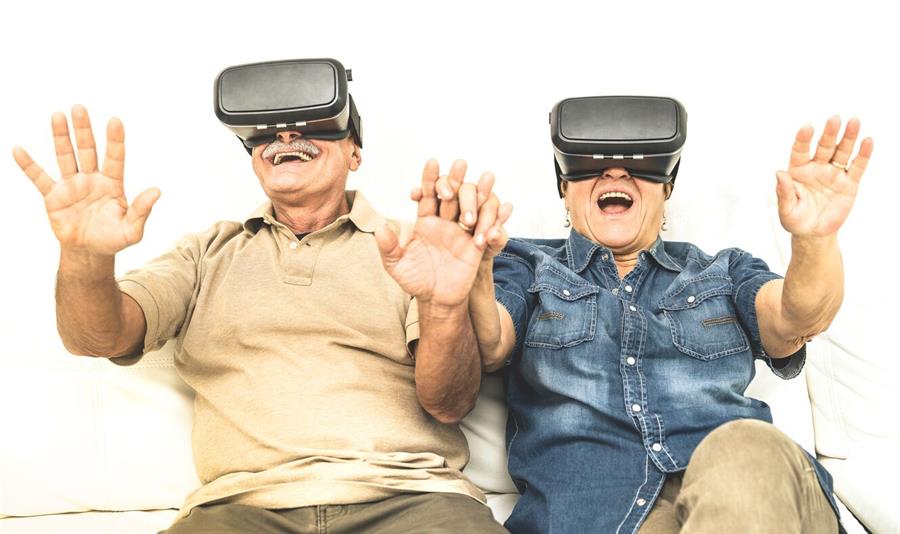Imagine the scenario: a grandmother fighting enemies in an online video game with her grandchildren or taking a virtual tour of a prestigious museum using a smartphone application in the comfort of her home.(1-3) This shouldn’t be so surprising since many people are taking an interest in immersive technologies, regardless of their age.
An "immersive" technology is a technology that aims to imitate the physical world through a digital or simulated world, creating a sense of immersion. An environment is totally immersive if it stimulates the five senses (vision, hearing, touch, smell, and taste), but also allows interaction and communication with others. Some immersive technologies use "virtual reality" to artificially reproduce a sensory experience (for example, you can recreate a virtual environment to help patients confront their fear of heights), while other technologies rely on "augmented reality" which superimposes virtual images on the real environment (for example, a smartphone application that enriches the visitor experience of a museum by providing content if the person watches through their phone).(4)
Immersive technologies are developing at great speed and have spread to many areas, such as arts, entertainment, education, the military and medicine.(4) Some people even envision that immersive technologies may be a promising way to break social isolation and loneliness among older adults.(3) But what does research tell us about this technological solution?
What research tells us
A systematic review identified 28 studies examining the use of immersive technologies in older adults.(5) The effects of immersive technologies on the social aspects of aging are still poorly studied, with emphasis mostly on cognitive, physical and sensory effects of these technologies. However, some studies reveal that immersive technologies have the potential to promote healthy aging.
The studies included in the systematic review examined a limited number of immersive technologies used by older adults: 1) games and simulations; 2) social-assistance robots; and 3) social technologies.
Games and simulations
The games included action games, strategy games, or multi-player online games. These types of games appear to have a positive influence on the attention, information processing and memory of older adults. More specifically, shooting games improved visual attention and speed of response. Strategy games helped to improve memory. Role-playing games improved memory and reasoning skills. As for multi-player online games, they improved the speed of response, reasoning and memory in the context of social interactions with other players.
Robots
Social-assistance robots (including robotic pets) aim to improve the quality of life of seniors. These robots can help to perform daily activities (eating, bathing, managing drugs), but also can improve mobility, improve cognitive functions and provide a sense of security. Some robots interact verbally and with facial expressions to simulate emotions, which in turn encouraged older adults to express themselves more. They showed potential to improve the psychological well-being of older adults by addressing certain emotional needs, decreasing loneliness and promoting social interaction.
Social technologies
The so-called "social" technologies aim to help older adults communicate with the outside world. These technologies offer older adults opportunities to socialize and develop their social networks. Some social technologies can be integrated in the furniture in older adults' houses and can be connected with online social networks (for example, a digital picture frame connected to Facebook allowing users to view updated photos of their family members and interact with them). Although these technologies can facilitate social interactions despite mobility problems and bridge the distance between older adults and their loved ones, there are still obstacles that prevent some older adults from using them actively, such as the complexity of social technologies and the declining cognitive capacities of some older adults.
Immerse yourself in technologies... but proceed with caution
Our world may become smaller as we get older. Mobility problems can limit our activities and confine us to our homes. Our social networks can become more limited. Therefore, immersive technologies appear attractive to open a whole new world (even virtual) to older adults who may suffer from loneliness and social isolation.(3) That being said, the evidence on the effect of immersive technologies on loneliness and social isolation among older adults remains limited. Moreover, some experts expressed concerns about possible adverse effects of immersive technologies, which may actually increase social isolation.(6) Since these technologies are likely to take a much greater part in our daily lives, more and more people may prefer to spend the majority of their time in virtual spaces.(6) Other experts also revealed that people can be ostracized, ignored and excluded in virtual environments,(7) which may have negative consequences on their health and well-being. So, if you want to immerse yourself in these new technologies, proceed with caution and be aware that they may affect your health and well-being.





